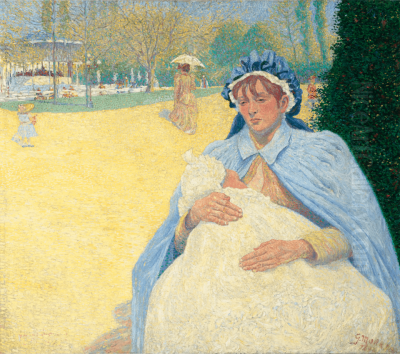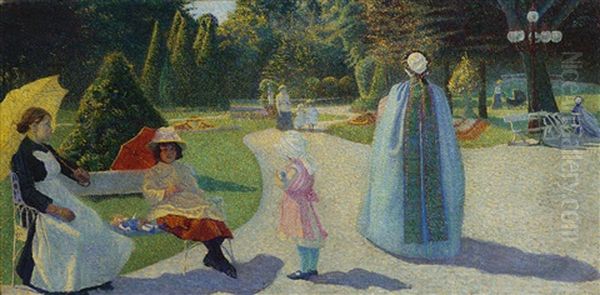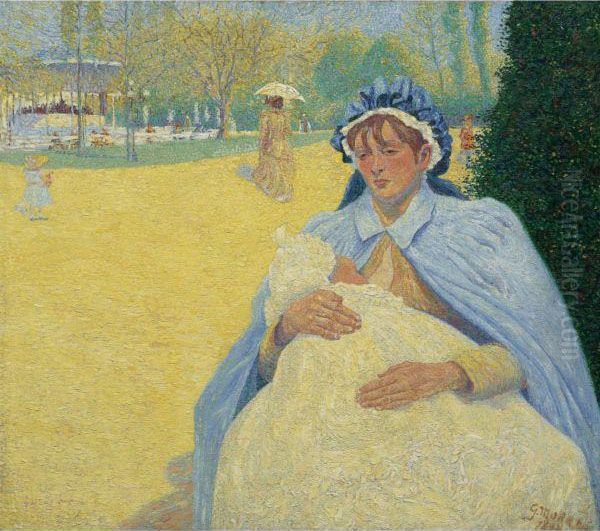
George Morren, a name perhaps not as universally recognized as some of his contemporaries, nonetheless carved a significant niche for himself within the vibrant and transformative art world of late 19th and early 20th century Europe. Born in Ekeren, near Antwerp, Belgium, on July 27, 1868, and passing away in Brussels on November 21, 1941, Morren's life and career spanned a period of intense artistic experimentation and redefinition. He emerged as a distinguished Belgian Post-Impressionist painter, a skilled pastellist, and a capable sculptor, leaving behind a body of work that reflects both the prevailing artistic currents of his time and a unique personal vision. His journey through Impressionism, Neo-Impressionism (Pointillism), and a more personal, intimate style showcases an artist continually exploring light, color, and form.
Early Life and Artistic Awakening
George Morren's artistic inclinations manifested early. His initial formal training took place in his native Antwerp, a city with a rich artistic heritage, notably as the home of Baroque master Peter Paul Rubens centuries earlier. Morren studied at the Antwerp Academy, but a pivotal influence during his formative years was the Belgian painter Emile Claus (1849-1924). Claus was a leading figure of Luminism, a Belgian variant of Impressionism that emphasized the effects of light, and his mentorship undoubtedly shaped Morren's early understanding of color and atmospheric representation.
Seeking to broaden his artistic horizons, Morren, like many aspiring artists of his generation, traveled to Paris. The French capital was the undisputed epicenter of the avant-garde, a crucible where new ideas were forged and artistic revolutions were launched. In Paris, he furthered his studies and absorbed the influences of the Impressionists, such as Claude Monet, Edgar Degas, and Camille Pissarro, who had already challenged academic conventions with their focus on capturing fleeting moments and the subjective experience of light and color. He also spent time in Brussels, another important center for artistic innovation, particularly for Symbolism and Art Nouveau. This period of study and immersion in different artistic environments was crucial for Morren's development, equipping him with a diverse set of skills and perspectives.

His talent did not go unnoticed. As early as 1890, Morren received an award for his painting, an early acknowledgment that affirmed his chosen path. This recognition likely emboldened him as he began to navigate the competitive art scene.
Foray into Neo-Impressionism and Les XX
The late 1880s and early 1890s were a period of fervent artistic debate, with Impressionism giving way to various Post-Impressionist tendencies. One of the most scientifically-grounded of these was Neo-Impressionism, pioneered by Georges Seurat (1859-1891) and Paul Signac (1863-1935). This technique, also known as Pointillism or Divisionism, involved applying small, distinct dots of pure color to the canvas, relying on the viewer's eye to optically blend them, thereby achieving greater luminosity and vibrancy.
Morren was drawn to this systematic approach to color. After reportedly seeing an exhibition of Seurat's work in Paris, he embraced Pointillism and became one of its notable Belgian practitioners. He joined the burgeoning circle of Belgian Neo-Impressionist painters, a group that included prominent artists like Théo van Rysselberghe (1862-1926), Henry Van de Velde (1863-1957), and Alfred William Finch (1854-1930). These artists were often associated with the avant-garde group "Les XX" (Les Vingt), founded in Brussels in 1883 by Octave Maus.
Les XX was a radical exhibiting society that played a crucial role in introducing international modern art to Belgium. It had no jury and invited a mix of Belgian and international artists, becoming a platform for Impressionism, Neo-Impressionism, Symbolism, and early Art Nouveau. Members included James Ensor, Fernand Khnopff, and the aforementioned Van Rysselberghe. Les XX invited international luminaries like Claude Monet, Camille Pissarro, Auguste Renoir, Georges Seurat, Paul Gauguin, and Vincent van Gogh to exhibit alongside its members. In 1891, George Morren participated in the eighth exhibition of Les XX, a significant milestone that placed him firmly within the Belgian avant-garde. His participation underscored his commitment to modern artistic principles and his association with the leading innovators of the day.
Masterworks and Stylistic Evolution

Morren's engagement with Pointillism resulted in some of his most celebrated works. A prime example is his painting A l'harmonie (At the Harmony Park), also known as Sunday Afternoon in the Park or Dimanche après-midi au parc. This piece, created in the early 1890s, is a quintessential example of his Pointillist style. It depicts figures enjoying a leisurely day in a park, rendered with meticulous dots of color that create a shimmering, luminous effect. The composition is carefully structured, and the interplay of light and shadow is masterfully handled. Today, A l'harmonie is held in the prestigious collection of the Musée d'Orsay in Paris, a testament to its art historical importance.
While Pointillism was a significant phase in Morren's career, he did not remain rigidly attached to it. Like many Post-Impressionists, his style evolved. He explored various themes, including landscapes, portraits, intimate interior scenes bathed in sunlight, and still lifes. His landscapes often captured the serene beauty of the Belgian countryside, while his interiors, frequently featuring female figures, are characterized by a sensitivity to light and mood. These works often show a move towards a more fluid application of paint, though the lessons learned from Neo-Impressionism regarding color theory and light often remained evident.
Another notable work, Le Renouveau (The Renewal), offers insight into Morren's thematic concerns and his sensitive portrayal of human subjects. The painting depicts a wet nurse breastfeeding a child. This subject, while touching upon traditional mother-and-child imagery, also places the woman in a working context, reflecting a more secular and perhaps even industrialized view of roles that were once purely domestic or idealized. This nuanced portrayal demonstrates Morren's ability to imbue his subjects with both tenderness and a sense of contemporary reality.
His connection with the renowned Impressionist Pierre-Auguste Renoir (1841-1919) is also mentioned in his biography. While the exact nature and extent of this relationship require deeper research, it suggests Morren moved within circles that included some of the most influential artists of his time. Renoir, known for his vibrant depictions of modern life and his later, more classical nudes, could have offered Morren insights into color, form, and the sensuous depiction of the human figure, or perhaps they shared an affinity for certain themes or exhibition venues.
Diverse Artistic Pursuits and Keen Observation
Beyond his primary focus on painting and pastels, George Morren also ventured into the realm of applied arts, specifically jewelry design. This diversification was not uncommon among artists of the Art Nouveau period, who sought to break down the barriers between fine and applied arts. In 2022, the King Baudouin Foundation in Belgium acquired a remarkable collection of buttons and coat clasps designed by Morren. These pieces, likely created with an eye for elegance and originality, demonstrate his versatility and his engagement with the broader aesthetic movements of his era, which emphasized the artistic value of everyday objects.
Morren's artistic sensibility was underpinned by a keen and sometimes unconventional power of observation. Anecdotes suggest he possessed a meticulous eye for the details of the natural world. For instance, he is said to have noted the textural similarity between freshly excreted dung and oil paint, a rather earthy comparison that nonetheless speaks to an artist's constant analysis of material qualities. He also reportedly observed the near-immobility of earthworms near their burrow entrances. Such observations, while perhaps quirky, highlight an intense engagement with the physical world, a quality that would have informed his depictions of landscapes and natural elements. This attentiveness to the minutiae of nature often translates into a sense of authenticity and lived experience in an artist's work.
Exhibitions and Later Career
Throughout his career, George Morren actively exhibited his work, ensuring its visibility to the public and critics. Between 1900 and 1905, he held exhibitions in key cities such as Brussels, Antwerp, and Luxembourg. These shows would have featured the evolution of his style beyond his stricter Pointillist phase, showcasing his mature work which often blended the luminosity of Impressionism with a solid Post-Impressionist structure and a personal, intimate sensibility.
His oeuvre encompasses a wide range of subjects, reflecting a versatile artistic temperament. He painted sun-drenched gardens, tranquil domestic interiors, portraits that captured the personality of his sitters, and still lifes that allowed for focused studies of form, color, and texture. The consistent thread through his work is a profound engagement with light and its effects, a legacy of his early training with Emile Claus and his immersion in Impressionist and Neo-Impressionist principles.
While perhaps not achieving the same level of international fame as some of his exact contemporaries like Vincent van Gogh (who also exhibited with Les XX) or Paul Gauguin, Morren's contribution to Belgian art is undeniable. He was part of a generation that navigated the complex transition from the 19th to the 20th century, absorbing and reinterpreting the radical innovations of Impressionism and forging new paths. His work reflects the intellectual rigor of Neo-Impressionism, the visual delight of Impressionism, and a deeply personal engagement with his subjects.
Legacy and Conclusion
George Morren's artistic journey reflects the dynamic spirit of his age. From his academic beginnings in Antwerp to his embrace of Parisian avant-gardism and his significant role within Belgian Neo-Impressionist circles, he consistently sought to explore the expressive possibilities of color and light. His association with Emile Claus provided a foundation in Luminism, while his adoption of Pointillist techniques, inspired by Seurat, marked a key phase of his development, producing works like the celebrated A l'harmonie.
His participation in Les XX placed him at the forefront of the Belgian avant-garde, alongside figures like Théo van Rysselberghe and James Ensor, and in the company of international giants. Morren's diverse output, spanning paintings, pastels, and even jewelry design, reveals an artist of broad interests and refined sensibilities. His keen observational skills, sometimes leading to unique insights into the natural world, further enriched his artistic practice.
Though he may be considered one of the "lesser-known" Pointillists on the wider international stage compared to Seurat or Signac, or even Van Rysselberghe, George Morren remains an important figure in the history of Belgian art. His paintings, characterized by their luminous qualities, thoughtful compositions, and sensitive portrayals, continue to be appreciated for their beauty and technical skill. His works serve as a vital link in understanding the transmission and adaptation of Post-Impressionist ideas in Belgium, contributing to a rich national artistic tradition that was both receptive to international currents and capable of producing its own distinct voices. George Morren was undoubtedly one such distinctive and accomplished voice.